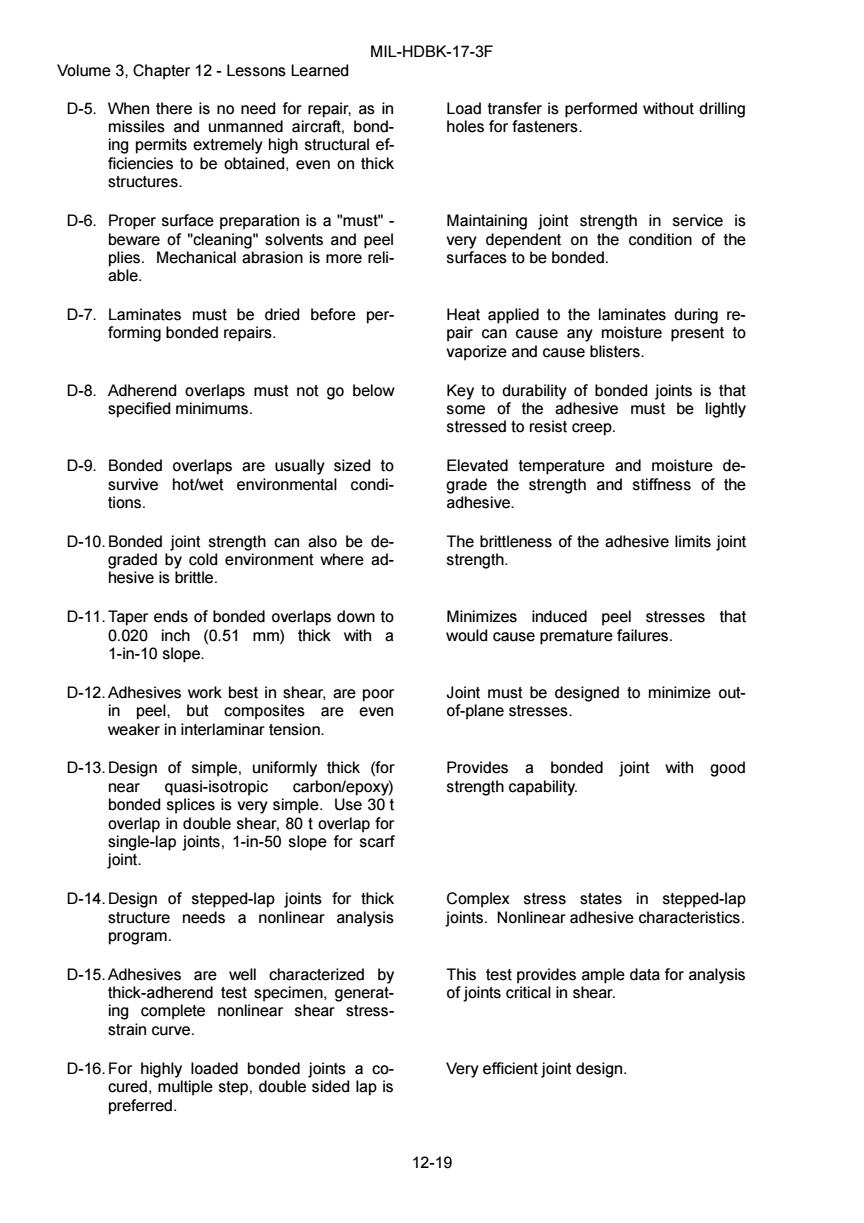正在加载图片...

MIL-HDBK-17-3F Volume 3.Chapter 12-Lessons Learned D-5.When there is no need for repair,as in Load transfer is performed without drilling missiles and unmanned aircraft.bond- holes for fasteners. ing permits extremely high structural ef- ficiencies to be obtained.even on thick structures. D-6.Proper surface preparation is a "must"- Maintaining joint strength in service is beware of "cleaning"solvents and peel very dependent on the condition of the plies.Mechanical abrasion is more reli- surfaces to be bonded. able. D-7.Laminates must be dried before per- Heat applied to the laminates during re- forming bonded repairs. pair can cause any moisture present to vaporize and cause blisters. D-8.Adherend overlaps must not go below Key to durability of bonded joints is that specified minimums. some of the adhesive must be lightly stressed to resist creep. D-9.Bonded overlaps are usually sized to Elevated temperature and moisture de- survive hot/wet environmental condi- grade the strength and stiffness of the tions adhesive. D-10.Bonded joint strength can also be de- The brittleness of the adhesive limits joint graded by cold environment where ad- strength. hesive is brittle D-11.Taper ends of bonded overlaps down to Minimizes induced peel stresses that 0.020 inch (0.51 mm)thick with a would cause premature failures. 1-in-10 slope. D-12.Adhesives work best in shear,are poor Joint must be designed to minimize out- in peel,but composites are even of-plane stresses. weaker in interlaminar tension. D-13.Design of simple,uniformly thick (for Provides a bonded joint with good near quasi-isotropic carbon/epoxy) strength capability. bonded splices is very simple.Use 30 t overlap in double shear,80 t overlap for single-lap joints,1-in-50 slope for scarf joint. D-14.Design of stepped-lap joints for thick Complex stress states in stepped-lap structure needs a nonlinear analysis joints.Nonlinear adhesive characteristics. program. D-15.Adhesives are well characterized by This test provides ample data for analysis thick-adherend test specimen,generat- of joints critical in shear. ing complete nonlinear shear stress- strain curve. D-16.For highly loaded bonded joints a co- Very efficient joint design. cured,multiple step,double sided lap is preferred. 12-19MIL-HDBK-17-3F Volume 3, Chapter 12 - Lessons Learned 12-19 D-5. When there is no need for repair, as in missiles and unmanned aircraft, bonding permits extremely high structural efficiencies to be obtained, even on thick structures. Load transfer is performed without drilling holes for fasteners. D-6. Proper surface preparation is a "must" - beware of "cleaning" solvents and peel plies. Mechanical abrasion is more reliable. Maintaining joint strength in service is very dependent on the condition of the surfaces to be bonded. D-7. Laminates must be dried before performing bonded repairs. Heat applied to the laminates during repair can cause any moisture present to vaporize and cause blisters. D-8. Adherend overlaps must not go below specified minimums. Key to durability of bonded joints is that some of the adhesive must be lightly stressed to resist creep. D-9. Bonded overlaps are usually sized to survive hot/wet environmental conditions. Elevated temperature and moisture degrade the strength and stiffness of the adhesive. D-10. Bonded joint strength can also be degraded by cold environment where adhesive is brittle. The brittleness of the adhesive limits joint strength. D-11. Taper ends of bonded overlaps down to 0.020 inch (0.51 mm) thick with a 1-in-10 slope. Minimizes induced peel stresses that would cause premature failures. D-12. Adhesives work best in shear, are poor in peel, but composites are even weaker in interlaminar tension. Joint must be designed to minimize outof-plane stresses. D-13. Design of simple, uniformly thick (for near quasi-isotropic carbon/epoxy) bonded splices is very simple. Use 30 t overlap in double shear, 80 t overlap for single-lap joints, 1-in-50 slope for scarf joint. Provides a bonded joint with good strength capability. D-14. Design of stepped-lap joints for thick structure needs a nonlinear analysis program. Complex stress states in stepped-lap joints. Nonlinear adhesive characteristics. D-15. Adhesives are well characterized by thick-adherend test specimen, generating complete nonlinear shear stressstrain curve. This test provides ample data for analysis of joints critical in shear. D-16. For highly loaded bonded joints a cocured, multiple step, double sided lap is preferred. Very efficient joint design